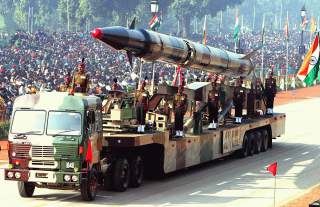Could China Help Pakistan Make Its Nuclear Arsenal Even Deadlier?
Pakistan’s nuclear missile program just got a major boost from China.
Last week, Chinese officials confirmed the sale of a sophisticated optical tracking system to Pakistan. The nation has been developing multiwarhead nuclear missiles, and the infusion of advanced Chinese tech brings it one step closer.
Optical systems are critical in missile testing, providing engineers valuable high-resolution images of a missile’s multiple stages that can be used to improve designs.
The sale marks the first time China has sold such sensitive technology to a foreign country, and comes after India successfully tested a powerful long-range ballistic missile in January. The missile, the Agni-V, has a range of over 5,000 km putting all of China within nuclear striking distance as well as parts of Europe and Africa.
India’s arsenal is already capable of hitting targets across Pakistan, as the two nations have long been locked in a nuclear arms race. In 1998, India and Pakistan tested their first nuclear bombs within one day of one another, and have since sought to outpace the other’s missile development and nuclear technology.
Recommended: The World’s Most Secretive Nuclear Weapons Program.
Recommended: The Fatal Flaw That Could Take Down an F-22 or F-35.
Recommended: Smith & Wesson's .44 Magnum Revolver: Why You Should Fear the 'Dirty Harry' Gun
India has focused on building single nuclear warhead missiles, while Pakistan has sought to develop multiple independently targetable re-entry vehicles (MIRVs), a missile carrying multiple warheads that can strike different targets.
Though India’s missiles are capable of carrying larger payloads and flying further, Pakistan’s MIRVs would allow it to overwhelm India’s missile defense system and hit several targets with a fewer number of missiles.
India has yet to develop the technology for a multiwarhead missile, and there are fears that Pakistan’s MIRV technology could shift the balance between Pakistan and India.
Testifying before Congress in March, U.S. Defense Intelligence Agency director Robert Ashley confirmed that “In January 2017, Pakistan conducted the first test launch of its nuclear-capable Ababeel ballistic missile, demonstrating South Asia’s first MIRV payload.”
Analysts believe Pakistan’s MIRV technology has yet to be perfected, but the latest acquisition of a Chinese optical system will significantly aid development.
In missile testing, optical systems consist of specialized telescopes equipped with a high-speed camera, infrared detector, laser ranger, and a tracking system that captures and follows targets. With this system, missile designers are able to view high-resolution images from each stage of the missile including launch, separation, re-entry and the release of warheads.
The Chinese system that Pakistan acquired is unique for its four telescope units. Each unit is placed at a different location to capture highly detailed and accurate images from multiple angles. With multiple warheads, the additional telescopes allow the system to more easily track each warhead simultaneously.
Rong Jili, Beijing Institute of Technology’s School of Aerospace Engineering’s deputy director, explained that high-quality optics are especially critical in the development of MIRVs. While radar and other tracking systems can collect more precise data at long distances, optical systems provide direct feedback.
“Seeing it with our own eyes is completely different from mining dry data. It helps to not only diagnose problems, but also generate inspiration,” Rong told the South China Morning Post.
A Chinese team spent three months in Pakistan assembling the system and training locals on how to use it.
China has long partnered with Pakistan, covertly assisting the nation in developing nuclear weapons during the Cold War. More recently, China has helped Pakistan develop several nuclear reactors and regularly sells the nation fighter jets, submarines, short-range missiles and unmanned drones.
In 2017, Pakistan bolstered its air defenses by spending $373 million on Chinese anti-air missiles to ward off Indian jets.
Both nations have had a tense relationship with India, which has resulted in several armed conflicts over the past seven decades.
For two months last summer, Chinese and Indian troops faced off on a remote plateau in the Himalayas. The region sits along a disputed border between the two countries, and tensions rapidly mounted before both sides eventually reached an agreement.
Eugene K. Chow writes on foreign policy and military affairs. His work has appeared in Foreign Policy, The Week, and The Diplomat.
Image: Wikimedia Commons.

